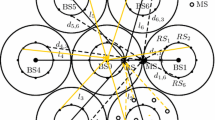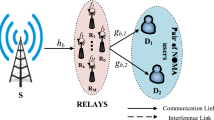Abstract
In recent years, there has been an upsurge of interest in relay-augmented infrastructure-based networks. On the other hand, multiple-input-multiple-output (MIMO) wireless system becomes a hot topic for it can achieve significant increases in overall system performance. This paper gives a detailed analysis of downlink performance of MIMO relaying networks, in which different channel models and classic MIMO cellular system model with fixed relay are considered. Our results in single cell scenario show that when meeting effective relay system efficiency of 100%, the required relay SNR gain of 2-antenna system can be reduced to less than half of that with only one transceiver antenna. We also observe that MIMO is more tolerant to interference compared with the one-transceiver antenna system. After that, multi-hop architecture is researched and statistics figures out the tolerable number of hops which is supported in wireless communication with a view to real application. In addition, multi-cell scenario is also studied. Statistics results show that there is more 8 dB average spectral efficiency gain in a two-hop fixed relay 4 × 4 MIMO system than that in a SISO system. These results present significant indications in deployment and optimization of relay-based MIMO networks.
Similar content being viewed by others
References
Tsoulos G. (2006) MIMO System technology for wireless communications. CRC Press, USA
Yanikomeroglu, H. (2002). Fixed and mobile relaying technologies for cellular networks. In Proceedings of Second Workshop on Applications and Services in Wireless Networks (ASWN’02) (pp. 75–81).
Periyalwar S., Hashem B. (2003) Future mobile broadband wireless networks: A radio resource management perspective. Wireless Communications And Mobile Computing, 3: 803–816
Rodriguez, M. A. G. (2004). Cooperative MIMO relaying. Master Thesis, Department of signals, sensors and systems, KTH (Kungl Tekniska Hogskolan)
(2008). Draft amendment to IEEE standard for local and metropolitan area networks, part 16: Air interface for fixed and mobile broadband wireless access system, IEEE S.
Redana, S., Doppler, K., Schultz, D., Wodczak, M., Rost, P., Hamm, L., Dottling, M., & Perez, Q. (2007). Final assessment of relaying concepts for all CGs scenarios under consideration of related WINNER L1 and L2 protocol functions. IST-4-027756 WINNER II.
Tang, X. (2003). Coverage enhancement with analog fixed relaying in cellular radio networks. M.A.Sc. Thesis, Carleton University.
Goldsmith A. (2003) Capacity limits of MIMO Channels. IEEE Journal on selected areas in communications 21(5): 23–31
Dohler M., Gkelias A., Aghvami H. (2003) 2-hop distributed MIMO communication system. IEE Electronics Letters 39(18): 224–229
Bian, Y. Q., Nix, A. R., Sun, Y., & Strauch, P. (2007). Performance evaluation of mobile WiMAX with MIMO and relay extensions. In Wireless Communications and Networking Conference (pp. 1814–1819).
Wang B., Zhang J., Host-Madsen A. (2005) On the capacity of MIMO relay channels. IEEE Transactions on Information Theory 51(1): 29–43
Gomadam K. S., Jafar S. A. (2006) On the capacity of memoryless relay networks. IEEE International Conference on Cummunications 4: 1580–1585
Gomadam K. S., Jafar S. A. (2007) Optimal relay functionality for SNR maximization in memoryless relay networks. IEEE Journal on Selected Areas in Communications 25(2): 390–401
Kanakis, T. & Rapajic, P. B. (2007). Relaying MIMO channel capacity with imperfect channel knowledge at the receiver. In Proceedings of IEEE Mobile WiMAX ’07 Symposium (pp. 80–84), Orlando, FL, USA.
Kanakis, T. & Rapajic, P. B. (2007). MIMO relay channels with partial channel knowledge/estimation error and spatial correlation. International Conference on Signal Processing and Communication Systems, Gold Cost, Australia.
Constantinides, A. & Shacham, A. (2004). MIMO wireless system. Columbia. edu. http://www.columbia.edu/~acc40/MIMO.pdf.
ALCATEL. 3GPP R1-05-0407. (2005). Interference coordination in new OFDM DL air interface [R]. Athens, Greece: 3GPP TSGRAN WG1 Group.
WiMAX Forum. (2006). Mobile WiMAX-Part I: A technical overview and performance evaluation [R]. [S. l.]: WiMAX fORUM.
Sreng, V. (2002). Coverage enhancement through two-hop relaying in cellular radio systems. M.A.Sc. Thesis, Carleton University.
Yanikomeroglu H., Falconer D. D., Sreng V. M. (2002) Coverage enhancement through two-hop peer-to-peer relaying in cellular radio networks. World Wireless Research Forum (WWRF) meeting 7: 55–60
Hoymann, C., Klagges, K., & Schinnenburg, M. (2006). Multihop communication in relay enhanced IEEE 802.16 networks. In Proceedings of the 17th Annual IEEE International Symposium on Personal Indoor and Mobile Radio Communications (PIMRC”06), Helsinki, Finland (pp. 1104–1109).
Sun, Y., Bian, Y. Q., & Strauch, P. et al. (2007). Study of radio resource sharing for future mobile WiMAX application with relays. In Proceedings of Mobile WiMAX Symposium, IEEE, (pp. 91–97).
Author information
Authors and Affiliations
Corresponding author
Rights and permissions
About this article
Cite this article
Wang, P., Zu, L., Liu, F. et al. Downlink Performance Analysis of MIMO Relaying Networks. Wireless Pers Commun 62, 729–746 (2012). https://doi.org/10.1007/s11277-011-0404-6
Published:
Issue Date:
DOI: https://doi.org/10.1007/s11277-011-0404-6




